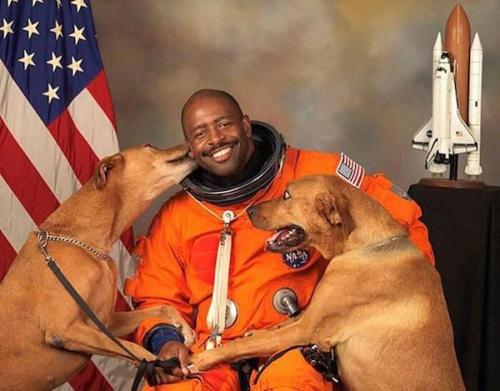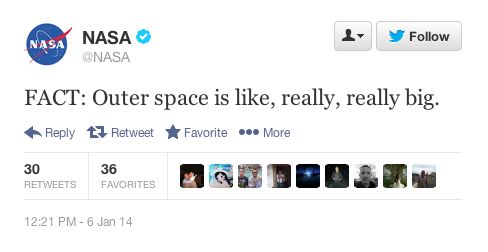Southern Cross By Carlos Fairbairn

Southern Cross by Carlos Fairbairn
js
More Posts from Intergalacticnerd and Others

Astronaut Leland Melvin includes his rescued dogs in best NASA portrait ever.











Watch: Leonardo DiCaprio calls to end climate change in Oscar acceptance speech.

Infant Star’s Artistic Outburst
The artistic outburst of an extremely young star, in the earliest phase of formation, is captured in this spectacular image from the NASA/ESA Hubble Space Telescope. The colourful wisps, found in the lower left of the image, are painted onto the sky by a young star cocooned in the partially illuminated cloud of obscuring dust seen to the upper right.
Pictured punching through the enshrouding dust is an extremely hot, blue jet of gas released by the young star. As this jet speeds through space, it collides with cooler surrounding material. The result is the colourful object to the lower left, produced as the cooler material is heated by the jet (opo9524a, potw1307a).
This wispy object is known as HH34 and it is an example of a Herbig–Haro (HH) object. It resides approximately 1400 light-years away near the Orion Nebula, a large star formation region within the Milky Way. HH objects exist for a cosmically brief time — typically thousands of years — with changes seen in observations taken only a few years apart (heic1113).
Credit: ESA/Hubble & NASA
WHOA look at the moon
me literally every night no matter what phase the moon is in (via purple-space-freak)

M7, Open Star Cluster


Do not go where the path may lead, go instead where there is no path and leave a trail. —Ralph Waldo Emerson

Shuttle Plume Shadow Points to the Moon
In early 2001 during a launch of Atlantis, the Sun, Earth, Moon, and rocket were all properly aligned for this photogenic coincidence. First, for the space shuttle’s plume to cast a long shadow, the time of day must be either near sunrise or sunset. Only then will the shadow be its longest and extend all the way to the horizon. Finally, during a Full Moon, the Sun and Moon are on opposite sides of the sky. Just after sunset, for example, the Sun is slightly below the horizon, and, in the other direction, the Moon is slightly above the horizon. Therefore, as Atlantis blasted off, just after sunset, its shadow projected away from the Sun toward the opposite horizon, where the Full Moon just happened to be.
Image Credit: Pat McCracken, NASA
(via NASA)


It was just discovered that there is a large ocean of water deep within the surface of Saturn’s icy moon, Enceladus.
-
 antipocalypse reblogged this · 1 week ago
antipocalypse reblogged this · 1 week ago -
 antipocalypse liked this · 1 week ago
antipocalypse liked this · 1 week ago -
 thevampireconnoisseur liked this · 1 week ago
thevampireconnoisseur liked this · 1 week ago -
 thevampireconnoisseur reblogged this · 1 week ago
thevampireconnoisseur reblogged this · 1 week ago -
 melisa-may-taylor72 liked this · 6 years ago
melisa-may-taylor72 liked this · 6 years ago -
 thefuckword-deactivated1637 liked this · 6 years ago
thefuckword-deactivated1637 liked this · 6 years ago -
 probablecheese reblogged this · 6 years ago
probablecheese reblogged this · 6 years ago -
 adamdemson liked this · 6 years ago
adamdemson liked this · 6 years ago -
 entropikuro liked this · 6 years ago
entropikuro liked this · 6 years ago -
 nib333 reblogged this · 6 years ago
nib333 reblogged this · 6 years ago -
 nib333 liked this · 6 years ago
nib333 liked this · 6 years ago -
 wishuthebest9 liked this · 6 years ago
wishuthebest9 liked this · 6 years ago -
 lathbora-virann reblogged this · 6 years ago
lathbora-virann reblogged this · 6 years ago -
 tyyiyi liked this · 6 years ago
tyyiyi liked this · 6 years ago -
 16fahri liked this · 6 years ago
16fahri liked this · 6 years ago -
 wearethehallowe liked this · 6 years ago
wearethehallowe liked this · 6 years ago -
 lovethatgirlido reblogged this · 6 years ago
lovethatgirlido reblogged this · 6 years ago -
 lovethatgirlido liked this · 6 years ago
lovethatgirlido liked this · 6 years ago -
 xavier-landrau liked this · 6 years ago
xavier-landrau liked this · 6 years ago -
 gecileves liked this · 6 years ago
gecileves liked this · 6 years ago -
 yeetingmyselftothemoon liked this · 6 years ago
yeetingmyselftothemoon liked this · 6 years ago -
 golden-nite-blog liked this · 6 years ago
golden-nite-blog liked this · 6 years ago -
 swampstitches reblogged this · 6 years ago
swampstitches reblogged this · 6 years ago -
 strawberryspine reblogged this · 6 years ago
strawberryspine reblogged this · 6 years ago -
 glitterbomb-ash reblogged this · 6 years ago
glitterbomb-ash reblogged this · 6 years ago -
 holidayinmurdercity reblogged this · 6 years ago
holidayinmurdercity reblogged this · 6 years ago -
 imafuckenalien reblogged this · 7 years ago
imafuckenalien reblogged this · 7 years ago -
 ilikebudz reblogged this · 7 years ago
ilikebudz reblogged this · 7 years ago
"Astronomy compels the soul to look upwards and leads us from this world to another." - Plato
147 posts